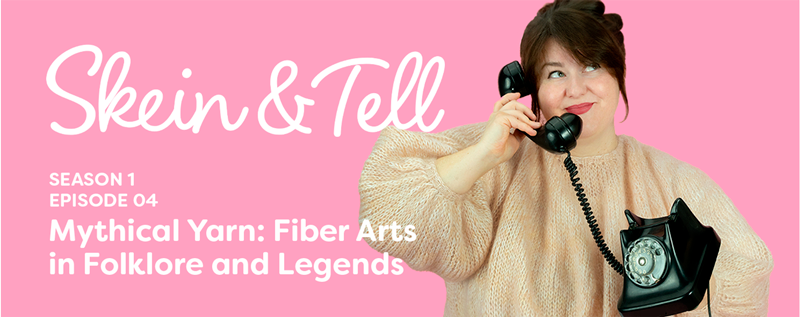Whether you’re here for the fiber facts or the folklore, this episode will change the way you look at your stitches. It’s a love letter to the timeless art of yarn, seen through the lens of stories that shaped civilizations. Perfect for knitters, crocheters, mythology buffs, and anyone who’s ever felt like their yarn had a little magic in it.

Welcome back, besties, to Skein and Tell, Hobbii’s official podcast, where yarn lovers unite to explore all things fiber, community, and creativity. 🧶
Episode 4 is here and it's nothing short of magical. Join our host Gea on a spellbinding journey as she uncovers the ancient legends, enchanted stories, and mythical threads that tie yarn, knitting, and crochet to folklore across cultures and centuries.
From Norse goddesses to Greek Fates, enchanted cloaks to nettle socks, this episode proves that yarn isn’t just a craft, it’s cosmic!
Listen to Skein and Tell Episode 4 Now
Ready to hear it all straight from Gea? 🎙️ Press play, or scroll down to read the full transcript below.
Choose Where to Listen:
Here's what you'll learn in this episode:
🎙️ (1:14) The Norns – Weaving Fate in Norse Mythology
Meet Urd, Verdandi, and Skuld: the trio of Norse goddesses who spin the threads of destiny beneath the roots of Yggdrasil. Discover how their eternal weaving reflects the deeper symbolism of time, fate, and fiber arts.
🏛️ (3:19) Jason and the Golden Fleece
Dive into Greek mythology and follow Jason and the Argonauts on a quest for the legendary Golden Fleece. A tale of kingship, dragons, and divine wool, it’s a fleece story every yarn-lover should know.
🧵 (5:15) Yarn Archaeology with Yarndiana Jones: The Story of Mohair
Gea takes a fabulous detour into the luxurious world of mohair with our rogue yarn historian, Yarndiana Jones. From Ottoman sultans to Texas ranchers, mohair has a legacy as rich as its texture.
⚖️ (12:29) The Moirai – Greek Fates and Spinning the Thread of Life
Clotho, Lachesis, and Atropos—the Greek goddesses of fate—show us how spinning can represent creation, measurement, and endings. Stitch by stitch, they remind us how every thread carries destiny.
🧙 (14:27) Enchanted Knitting in Fairy Tales
Witches, princesses, and fairies—oh my! Learn how magical beings use knitting and crochet to conjure cloaks of invisibility, time-traveling blankets, and life-saving garments.
🌿 (17:29) Weird Yarn Monday: Nettle Yarn
Yes, that nettle. Learn how this stinging plant became a sustainable fiber source and the irony of crafting soft, cozy socks from a plant that once ruined your childhood hikes.
🐺 (20:50) Cosmic Weaving, Fenrir, and Creation Myths
From Norse monster-binding threads to Native American Spiderwoman weaving the universe, explore how yarn links to cosmic power, creation, and control across world traditions.
Can’t tune in right now? Catch everything Gea covers in the episode below.
Want More? Read the Entire Episode
Below is an edited transcript from Episode 4: Mythical Yarn – Fiber Arts in Folklore and Legends, originally presented on the Skein and Tell podcast.
Introduction
Gea: Hi bestie! It's me, Gea, welcome back to Skein and Tell, the podcast that unravels it all. In today's episode, I will take you on an enchanting journey through time, legends, and myths as we explore the fascinating intersection of crochet, knitting, and folklore.
Now, yarn may seem like an everyday material—and I know it is for us—but throughout history, it has been woven into some of the most mystical and magical tales. Whether it's the creation of the world, the weaving of fate, or the crafting of enchanted garments, crochet and knitting have played a significant role in many legendary stories. So grab your favorite yarn and let's dive into the mythical threads that tie together the art of crochet, knitting, and folklore.
The Norns – Weaving Fate in Norse Mythology
Tune in at 1:14
Gea: Let's start with one of the oldest and most powerful symbols of yarn in mythology: the Norns from Norse mythology. These are three women often depicted sitting by the roots of the world tree, weaving the threads of fate for every living being. In Norse mythology, the Norns are not just spinsters—they're the ultimate weavers of destiny. They spin and weave the threads of life for gods and humans alike. Each one represents a part of the continuum of time: Urd (the past), Verdandi (the present), and Skuld (the future). Their work is often portrayed as an eternal cosmic weaving, where every decision made in the present affects the threads of the future.
This mythic connection between weaving and fate has persisted through human history. The Norns have parallels in many cultures' understanding of fate, like the Greek Moira or the Roman Parcae, who also use weaving or spinning to control destiny.
The Norns' eternal task of weaving the threads of life is a powerful image of how crocheting and knitting are associated with both creation and destruction.
Jason and the Golden Fleece
Tune in at 3:19
Gea: Another famous tale that brings yarn and mythical craftsmanship together is the story of the Golden Fleece from Greek mythology. In this legend, Jason and the Argonauts embark on a perilous journey to retrieve the Golden Fleece—a symbol of kingship and authority. The fleece itself was said to come from a magical ram sent by the gods. While not exactly knitted or crocheted, the idea of a magical fleece connects yarn to legendary power. Guarded by a dragon, the fleece was only attainable through incredible feats. It represents an object that holds the world together, much like knit or crochet work holds together threads of meaning, culture, and power.
The Archaeology of Yarn with Yarndiana Jones – The Story of Mohair
Tune in at 5:15
Gea: Today we’re talking about a fiber so luxurious, so ethereal, so ridiculously soft that it has graced the backs of royalty and rock stars alike. I’m talking about mohair. Mohair isn’t just a fancy word for your yarn-obsessed aunt—it’s a fiber with a history richer than a billionaire’s sock drawer.
Where does mohair come from? Not a mohair tree. Not an Angora rabbit (that’s Angora fiber). Mohair comes from the silky hair of the Angora goat. These goats, originally from Ankara, Turkey, are basically the supermodels of livestock. Long, curly locks. Naturally photogenic. High maintenance.
In the 13th century, the people of Turkey kept their Angora goats under lock and key. Mohair was so special that the goats were not allowed to leave the country. For centuries, this strategy worked. Mohair became the ultra-exclusive fabric worn by Ottoman sultans, Persian royalty, and basically anyone who wanted to scream "I’m fancy."
But in the 16th century, a few sneaky traders smuggled Angora goats out of Turkey, and suddenly mohair was an international sensation. The goats spread to Spain, France, South Africa, and eventually Texas—where by the 19th century, mohair was a booming industry. Queen Victoria adored it. Fashion houses embraced it. Rockstars flaunted it. From Beatles suits to Kurt Cobain’s iconic cardigan, mohair became the Beyoncé of the fiber world.
What makes mohair different? It's insanely soft, shiny, and strong. It resists wrinkles, holds its shape, and takes dye like a dream. It is, however, high maintenance—prone to shedding, and not fun to frog. But beauty comes at a price.
So next time you see a mohair sweater in a thrift shop, remember—you’re holding centuries of history and rebellious rockstar energy in your hands.
The Moira – Greek Fates and the Spinning Wheel of Destiny
Tune in at 12:29
Gea: In Greek mythology, the Moira—known as the Fates—are three sisters who determine the lifespan and destiny of all beings. Their tools? Spindles, threads, and the famous spinning wheel. Clotho spins the thread of life. Lachesis measures it. Atropos cuts it.
The spinning wheel becomes a powerful symbol not just of domestic life, but of fate itself. The act of spinning or weaving is a metaphor for how we create our own fate, stitch by stitch, moment by moment.
The symbolism of yarn and spinning in Greek mythology emphasizes how deeply thread and destiny are connected in folklore. Weaving is often seen as the act of creation, binding the very essence of life to a predetermined fate.
Enchanted Knitting and Magical Craft
Tune in at 14:27
Gea: Throughout European folklore, knitting and crochet are often tied to magic—used by witches, fairies, and other mystical beings to perform magical feats. In some stories, witches knit enchanted garments like cloaks of invisibility or time-traveling blankets. One tale tells of a princess who knits shirts from nettles to free her swan-transformed brothers—a testament to how patience and skill can literally break a curse.
Fairies too are said to knit magical clothing, imbuing their items with powers like protection or wish-granting. In these tales, crafting isn't just practical—it's a supernatural act.
Weird Yarn Monday: Nettle Yarn
Tune in at 17:29
Gea: Nettle yarn is made from the same plant that’s made generations of hikers itch—but don't worry, the stinging bits are removed in processing. Once feared, nettles are now part of sustainable yarn production. The irony? The same plant that tormented your ankles could now keep them warm. Just imagine the look on your friends’ faces when you tell them you’re knitting socks with nettle yarn!
Binding the Mythical – Fenrir and the Magical Thread
Tune in at 20:50
Gea: Even mythical creatures get in on the yarn magic. In Norse mythology, the monstrous wolf Fenrir—destined to bring about Ragnarok—could only be bound by an enchanted yarn called Gleipnir, made from six impossible ingredients. Though thin as silk, it was unbreakable.
In many cultures, cursed threads or enchanted weavings were used to trap or bind creatures like dragons or trolls. Heroes and heroines had to unravel threads of curses or craft garments to break spells. This highlights the dual nature of yarn in folklore—both creative and destructive.
Weaving and spinning appear as metaphors for the creation of the universe across cultures. The Hopi people tell of Spiderwoman, who wove the fabric of the world from threads of light. Greek goddess Athena also spun the thread of human destiny.
These stories reveal that the weaver or knitter isn’t just a craftsperson—they’re a symbol of cosmic interconnectedness. Every stitch holds the world together.
Closing
Gea: It’s incredible how crochet and knitting have been so deeply intertwined with myth and magic. From fate-weaving goddesses to enchanted garments, yarn represents both creation and control—life and death—and everything in between.
The myths we’ve explored remind us that the simple act of crafting is part of a vast tradition. When you pick up your crochet hook or knitting needles, you’re participating in something ancient, universal, and divine.
Thank you for joining me on this mythological journey through Skein and Tell. If you enjoyed this episode, be sure to subscribe and leave a review. And remember: every stitch you make is part of a story far bigger than ourselves—a magical thread woven through generations.
See you next time. Love you bestie, bye!
Loved This Deep Dive Into the Mythical Side of Crocheting and Knitting?
Keep exploring with Skein and Tell! Check out our next episodes for even more yarny tales like “How Yarn is Made - From Sheep to Skein?” and “The Secret Language of Stitches and Fibers.”
Skein and Tell Ep. 3: AI vs. Human – Can A Robot Knit or Crochet?
Skein and Tell Ep. 5: The Secret Language of Stitches and Fibers – Symbolism in Stitches
Psst! Don’t forget to send your stories to gea@hobbii.com.
